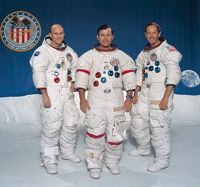Apollo 16 was the penultimate mission that landed people on the Moon. 
The crew was Commander John Young (right, center), Command Module Pilot Ken Mattingly (right, left), and Lunar Module Pilot Charlie Duke. Young was a very experienced astronaut, having flown aboard Gemini 3, Gemini 10, and Apollo 10. Duke and Mattingly were experienced fighter pilots but were making their first spaceflight. The people in charge of the American space program knew that funding for missions past Apollo 17 had been cut, so they knew that they had two missions left in which to find out as much as they could about the Moon's surface and surrounds. In particular, scientists wanted evidence with which to evaluate their theory that some lunar highlands and other features were caused by volcanism. After examining photographs taken by Apollo 14, they chose to land in the lunar highlands. As did the Apollo 15 crew, Young and Duke undertook extensive geological training, including field trips to various rock formations in New Mexico and in Canada. For his part, Mattingly trained by observing terrestrial geological formations from an airplane. 
Launch date was April 16, 1972. One experiment that the crew performed en route to the Moon involved light flashes. Crews as far back as Apollo 11 had reported seeing light flashes in the dark of space, even when they had their eyes shut. The crew wore a special helmet that was designed to track the movements of cosmic rays. Subsequent analysis proved NASA's theory that the astronauts were indeed observing cosmic rays. The crew entered lunar orbit three days later. Young and Duke touched down in the Descartes region of the central lunar highlands on April 20 and stepped out in that order. They had landed later than planned because of a slight malfunction in the Command Service Module. That delay would result in less time on the Moon and a return home a day earlier than planned. 

The Lunar Roving Vehicle, unveiled on Apollo 15, again featured in the extravehicular activity (EVA) of the astronauts, allowing them to range farther from the spacecraft than ever before. They covered nearly 17 miles, exploring several craters, taking pictures, recording data, and taking samples of both dust and rocks. They returned with the largest Moon rock of them all, named Big Muley. Duke plucked the 26-pound rock from the surface and made sure it got back to Earth. They did three EVAs in all. On the third day, they did close observation of a giant rock that they named House Rock, proving that it was a breccia (meaning made of a collection of minerals), not the result of a volcanic eruption. Among the upgrades on this mission were a mechanism to fix the TV camera aiming problems experienced by the Apollo 15 crew and an ultraviolet stellar camera to take pictures of the Earth and sky and capturing views not visible to the naked eye. One disappointment came when Young, in the midst of setting up a heat flow experiment, got one of his boots tangled up in the cable and pulled it out of the machine. The experiment could not go ahead. Many other experiments did, including one to measure the Moon's magnetic field Released from the service module while in lunar orbit was a small satellite designed to measure charged particles and magnetic fields in the larger lunar area. This satellite was similar to one released by Apollo 15. Neither satellite lasted long in orbit. Young and Duke spent 71 hours on the surface of the Moon; more than 20 of those were outside the Lunar Module. Duke left behind a photo of his family.
During the trip home, Mattingly did a deep space EVA, to retrieve film cassettes from the outside of the spacecraft and to deploy an experiment. Splashdown occurred on April 27. |
|
Social Studies for Kids
copyright 2002–2025
David White





